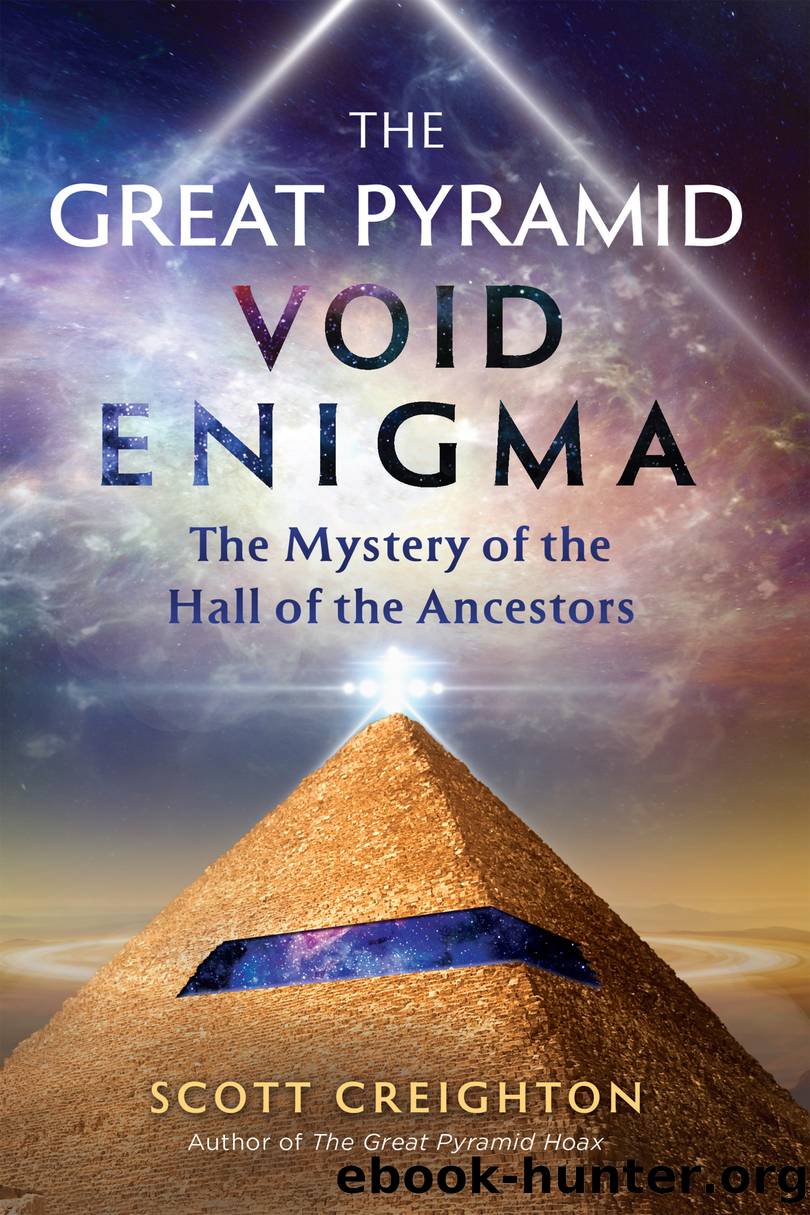The Great Pyramid Void Enigma by Scott Creighton

Author:Scott Creighton
Language: eng
Format: epub
Tags: Ancient Mysteries
Publisher: Inner Traditions/Bear & Company
Published: 2021-05-03T00:00:00+00:00
Similarly, the next Event Z date can be calculated as:
circa 2388 BCE + 7,693 years (periodicity) = circa 5305 CE.
IS GIZA TWELVE THOUSAND YEARS OLD?
The age of the Great Pyramid (and its contemporaries) is arguably one of the most hotly contested aspects of the Giza monuments, even among some mainstream Egyptologists, who, by and large, insist that they were all built circa 4,500 years ago, give or take a few hundred years. However, with the age of the Sphinx being pushed many thousands of years back in time (as a result of the research of the rebel Egyptologist, the late John Anthony West, along with the evidence presented by geologist Robert Schoch of Boston University), this has brought many to also question the age of the Great Pyramid itself, along with the other contemporary Old Kingdom pyramids in Egypt.
The stock response by Egyptologists to claims of a much greater antiquity for these monuments is probably best epitomized by Mark Lehner, who famously asked, âShow me a single potsherdâ of an older civilization with similar capabilities to those of the early dynastic Egyptians. Lehnerâs comment was made in the early 1990s during a debate with Schoch and, unfortunately, long before the 12,000-year-old megalithic site of Gobekli Tepe had been excavated by the German archaeologist, the late Klaus Schmidt, a site that clearly demonstrates that mankindâs ability to construct complex megalithic architecture comparable to that at Giza had been achieved many thousands of years earlier than had previously been thought possible.
It may be, however, that Lehner was actually asking the wrong question. Instead of asking âShow me a single potsherdâ of this purported older Egyptian civilization that built the pyramids, Lehner may have been better to consider the possibility that it is not the older civilization of ancient Egypt that has been lost but rather that it is a more recent Egyptian society that is lost to history. This is to say that it is a curious and documented fact that we have considerably more evidence of and know more about the preceding Old Kingdom period than we do, for example, of the more recent First Intermediate Period (FIP) of the ancient Egyptian civilization. You might ask why should this matter?
The periods in ancient Egypt we call the Old Kingdom and Middle Kingdom were separated from each other by a transition period that Egyptologists, as stated above, refer to as the First Intermediate Period. This transition period in ancient Egyptian history is often described by Egyptologists as a âdark ageâ since (comparatively) little is known about this time due to there being very little by way of monumental architecture or documentary records having survived from this period. Orthodox Egyptology believes that this dark age lasted around 150 years, from circa 2181 BCE to 2055 BCE6 and that it came to a close with the rise of the Twelfth Dynasty. The FIP is typically defined by Egyptology as a time when chaos existed all across Egypt, when the central authority of the pharaoh
Download
This site does not store any files on its server. We only index and link to content provided by other sites. Please contact the content providers to delete copyright contents if any and email us, we'll remove relevant links or contents immediately.
| Africa | Americas |
| Arctic & Antarctica | Asia |
| Australia & Oceania | Europe |
| Middle East | Russia |
| United States | World |
| Ancient Civilizations | Military |
| Historical Study & Educational Resources |
The Third Pole by Mark Synnott(676)
Money for Nothing by Thomas Levenson(624)
Christian Ethics by Wilkens Steve;(570)
The Economist (20210109) by calibre(563)
Made in China by Anna Qu(540)
100 Posters That Changed The World by Salter Colin T.;(498)
Reopening Muslim Minds by Mustafa Akyol(484)
Routledge Handbook of Contemporary India by Knut A. Jacobsen(476)
The Irish Buddhist by Alicia Turner(470)
Nonstate Warfare by Stephen Biddle(461)
Culture by Terry Eagleton(457)
The Great Pyramid Void Enigma by Scott Creighton(448)
The Age of Louis XIV: The Story of Civilization by Will Durant(435)
Ideology by Eagleton Terry;(432)
The Shortest History of China by Linda Jaivin(431)
Objects of Vision by Saab A. Joan;(425)
Banaras: CITY OF LIGHT by Diana L. Eck(423)
The Jews of Silence: A Personal Report on Soviet Jewry by Elie Wiesel(420)
Sybille Bedford by Selina Hastings(411)
